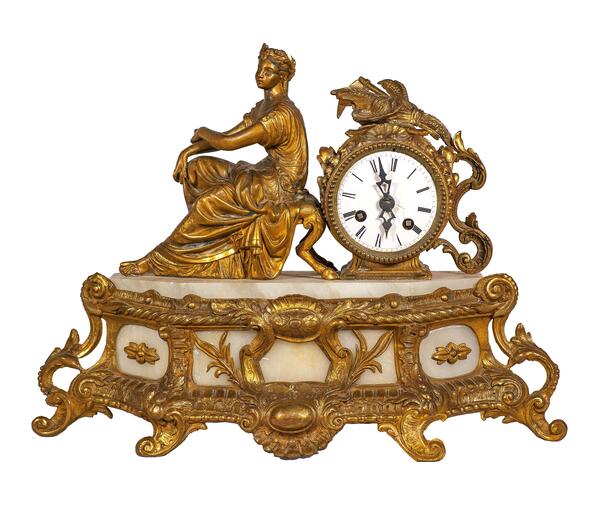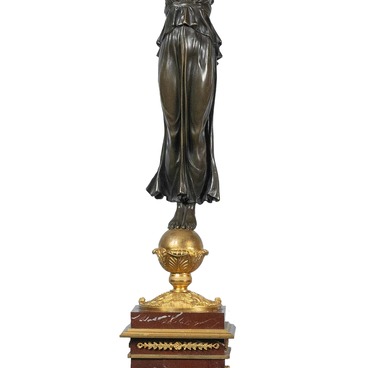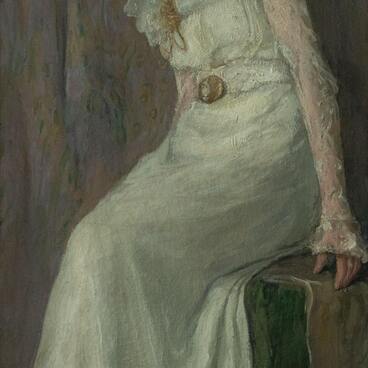By the mid-19th century, mantel clocks could be found in every noble house. They were considered more of a luxury item than a time-measuring device.
At this time, the classical style in art was replaced by historicism, which was characterized by a combination of different movements. Forms and elements of the past — splendid Baroque, whimsical Rococo, strict Gothic and solemn Empire — coexisted in one artistic trend. New style decisions also affected the design of mantel clocks. The most popular was neo-rococo, where a clock face was given a modest place among heaps of decor in the form of sculptural compositions, flowers, leaves, and whorls.
During that period, a lot of motifs were borrowed from ancient mythology. This interest was caused by the excavations in Pompeii and Herculaneum in the 18th century: statues, frescoes, furniture, and other household items, covered with a layer of volcanic ash for thousands of years after the eruption of Vesuvius, were well preserved. Sculptural compositions based on antique subjects harmonized with decorative and applied art objects, including mantel clocks.
The ‘Harvest’ clock, presented in the collection ‘The Old Mansion’, is made in the historicism style. The clock case is decorated with a bronze sculptural composition depicting Ceres — the Ancient Roman goddess of fertility and agriculture. She is depicted as a young girl in a tunic. Ceres sits on a cabriole legged stool. On the plinth on the right, there is a round clock face, decorated with leaves and whorls.
The clock was made by the French company of the Japy Freres brothers (Japy Brothers) in the mid-19th century. The company was founded in 1806 by the French watchmaker Frederic Japy, who was a student of the Swiss watchmaker Jean Jacques Perrelet. Perrelet was also the teacher of Abraham-Louis Breguet — the founder of the well-known premium watch brand.
Frederic Japy patented a machine for the production and processing of clock components, which could be used by middle-level craftsmen and allowed to reduce the cost of items. Japy’s clocks became the most popular ones in the 18th — 19th centuries.
At this time, the classical style in art was replaced by historicism, which was characterized by a combination of different movements. Forms and elements of the past — splendid Baroque, whimsical Rococo, strict Gothic and solemn Empire — coexisted in one artistic trend. New style decisions also affected the design of mantel clocks. The most popular was neo-rococo, where a clock face was given a modest place among heaps of decor in the form of sculptural compositions, flowers, leaves, and whorls.
During that period, a lot of motifs were borrowed from ancient mythology. This interest was caused by the excavations in Pompeii and Herculaneum in the 18th century: statues, frescoes, furniture, and other household items, covered with a layer of volcanic ash for thousands of years after the eruption of Vesuvius, were well preserved. Sculptural compositions based on antique subjects harmonized with decorative and applied art objects, including mantel clocks.
The ‘Harvest’ clock, presented in the collection ‘The Old Mansion’, is made in the historicism style. The clock case is decorated with a bronze sculptural composition depicting Ceres — the Ancient Roman goddess of fertility and agriculture. She is depicted as a young girl in a tunic. Ceres sits on a cabriole legged stool. On the plinth on the right, there is a round clock face, decorated with leaves and whorls.
The clock was made by the French company of the Japy Freres brothers (Japy Brothers) in the mid-19th century. The company was founded in 1806 by the French watchmaker Frederic Japy, who was a student of the Swiss watchmaker Jean Jacques Perrelet. Perrelet was also the teacher of Abraham-Louis Breguet — the founder of the well-known premium watch brand.
Frederic Japy patented a machine for the production and processing of clock components, which could be used by middle-level craftsmen and allowed to reduce the cost of items. Japy’s clocks became the most popular ones in the 18th — 19th centuries.



